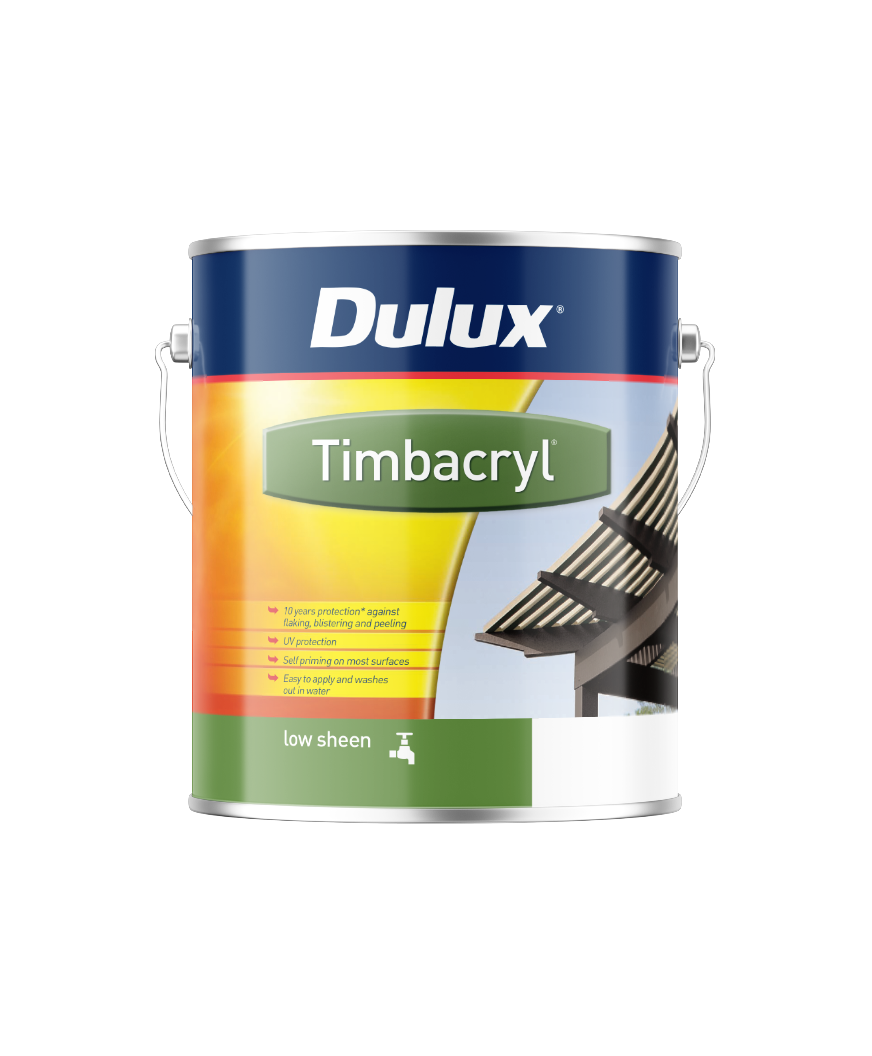Timbacryl®

About Timbacryl®
Dulux Timbacryl® provides a high opacity, long-lasting, Low Sheen, 100% acrylic finish for exterior timber and is ideal for fences and pergolas.
Dulux Timbacryl® colours have been carefully chosen for their ability to blend with both the natural environment and today's building materials. Timbacryl® also comes in a large selection of Dulux Colours of New Zealand® colours, so you can match your timber features to your paint colours.
Downloads
Application
*Refer to product label for full conditions. This guarantee does not limit and may not necessarily exceed your rights under the Consumer Guarantees Act 1993.
At a glance
- 10-year guarantee*
- 100% acrylic paint
- Made in New Zealand
- Same day recoat and easy clean up
- Pretinted colours available
- Eco Choice Aotearoa approved (License No: 705019)
Areas to use
Performance guide
Use Dulux Timbacryl over dressed and rough sawn timbers, pergolas, decking, fences, fascia boards, timber furniture, bricks, masonry, fibre cement sheeting, Zincalume® & galvanised iron.
Surfaces
• Dressed and rough-sawn timber
• Bricks
• Masonry
• Fibre cement sheeting
• Zincalume®
• Galvanised iron
10 year guarantee*
*Refer to product label for full conditions. This guarantee does not limit and may not necessarily exceed your rights under the Consumer Guarantees Act 1993.
Previously Painted Surfaces
Pre-primed timber and previously painted surfaces:
• Occasionally an apparently sound old paint will lose adhesion when recoated, particularly if the new paint is darker in colour.
• To avoid this, check the adhesion of the old paint by cutting an 'X' through a clean area of the film with a sharp knife, press cellulose tape firmly across the cut and rip it off.
• If the old paint comes off with the tape it should be removed before repainting.
• Scrape off all loose and flaking paint.
• Fill any cracks or holes with a suitable filler.
• Sand all surfaces to a flat finish and remove greyed timber.
• Dust off.
• Spot prime any bare areas with Dulux Timbacryl.
Unpainted Surfaces
Timber
1. Fill nail holes with a flexible, exterior grade wood filler.
2. Sand all dressed timber.
Brick, masonry, fibro and fibre cement board
1. Unpainted masonry surfaces should be cured for 28 days before painting.
2. Ensure surface is sound and clear of any loose sand or cement.
3. Fill holes with a grouting cement.
4. Wash down with water using a stiff brush to remove all loose material.
5. To remove any efflorescence (white slats) wipe down with a 5% solution of acetic acid (white vinegar).
6. Hose down and allow to dry.
7. Wash with a bleach solution and/or demossing chemical to remove mould, or moss.
8. Then hose down.
Galvanised iron
1. Clean with a Scotch-Brite nylon pad and sugar soap solution.
2. Thoroughly hose off.
3. Apply one coat of Dulux All Metal Primer.
Plastic spouting and downpipes
1. Sand all surfaces and dust off.
Steel and wrought iron
1. Remove all rust by scraping, sanding or wire brushing.
2. Apply two coats of Dulux All Metal Primer.
Brush, roller
Pre-primed timber and previously painted surfaces:
Apply two generous coats of Dulux Timbacryl.
Brick, masonry, fibro, fibre cement board and timber:
Apply three coats of Dulux Timbacryl.
Unused paint
Do not pour leftover paint down the drain.
Unwanted paint should be brushed out on newspaper and allowed to dry, and then disposed of via domestic waste collections.
For more information on responsible disposal of paint and packaging visit paintback.com.au or painttakeback.co.nz
For more information visit painttakeback.co.nz
Empty paint containers
Leave empty paint containers open in a well-ventilated area to dry out. When dry, recycle the container via steel can recycling programs.
Disposal of empty paint containers via domestic recycling programs may differ between local authorities. Check with your local council first.
Do not reuse container unless thoroughly decontaminated.
For more information on responsible disposal of paint and packaging visit paintback.com.au or painttakeback.co.nz
Shop with us when you want, how you want.
DuluxTRADE Online
Download the app to access the benefits of a DuluxTRADE account on the go.
Get detailed information about the physical and chemical properties of our products.
Advice for those challenges that arise in your busy and varied days.
Access technical product information and create project specifications.
